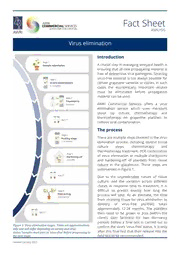
grapevine virus elimination fact sheet PDF
Preview grapevine virus elimination fact sheet
Fact Sheet ANALYSIS Virus elimination Introduction A crucial step in managing vineyard health is ensuring that all new propagating material is free of deleterious viral pathogens. Sourcing virus-free material is not always possible for certain grapevine varieties or clones. In such cases the economically important viruses must be eliminated before propagation material can be used. Please find AWRI Commercial Services offers a virus elimination service which uses meristem attached signed shoot tip culture, chemotherapy and thermotherapy on grapevine plantlets to remove viral Tcon&tamCina tiofno. rm. If The process there is anything There are multiple steps involved in the virus elimination process including several tissue cueltulres es tetphs, acth ewmotheer apcy anand thermotherapy treatment, PCR confirmation of virus elimination at multiple checkpoints and hartdeonin gs-ofif gof npla notletrs fryomo tiussue culture in the glasshouse. These steps are summarised in Figure 1. need before the Due to the unpredictable nature of tissue culture, and the variation across different 24/12, please let clones in response time to treatment, it is difficult to predict exactly how long the process will take. As an estimate, the time me know. from receiving tissue for virus elimination to delivery of virus-free plantlets takes approximately 12-24 months. The plantlets then need to be grown in pots (within the client’s own facilities) for two dormancy periods before a final test is carried out to Figure 1: Virus elimination stages. Times are approximations confirm the vine’s ‘virus-free’ status. It is onl y only and will differ depending on variety and virus after this final test that their release into the status.*samples must pass as ‘virus-free’ before progressing to the next stage. field would be recommended. Updated January 2022 Fact Sheet ANALYSIS Limitations Plants subjected to the virus elimination service will be provided ‘virus-free,’ with the possible exception of Grapevine rupestris stem pitting-associated virus (GRSPaV). GRSPaV is found in approximately 95% of all grapevines in Australia, is usually asymptomatic and is sometimes impossible to eliminate from vines. The ‘virus-free’ status is determined by a PCR-based screening method and is limited to the viruses within the AWRI complete virus screen (see Grapevine virus testing fact sheet for list). Other unknown viruses may also be removed during treatment, but this is not guaranteed. In some instances, a virus titre may be present at very low levels that is below the detection threshold of PCR detection. Screening is therefore required at multiple points through the elimination process and after two dormancies before the vines can be confidently given a ‘virus-free’ status. AWRI Commercial Services does not guarantee that the plants are ‘virus-free’ until this final testing is done. Please find Costs attached signed The virus elimination service has a base cost of $3,000 (excl. GST) per sample which provides clients with one virus-free plantlet. Additional plants can be requested upon submission, at a cost of $600 (excl. GST) per additional plant. This cost is based on potted plants bTein&g suCbm itfteod arndm inclu.d eIs:f • a full virus screen of plants on submission • all PCR testing throughout the elimination procetshs aned arfteer th ei stwo adornmayncty hholdi pnerigod • DNA-based variety ID on plants on submission and treated plants prior to delivery back to the customer. else that we can Payment is required in three stages: • 50% up-front payment upon submission to sign or you • 25% when plants test virus-free following treatment in tissue culture (following Stage 3 in Figure 1) • 25% upon receival of virus-free plants. need before the Submission of samples 24/12, please let Potted plants are preferred. Each pot should contain at least two actively growing vines which originated from the same vine. Woody canes or dormant rootlings are also accepted (approximately 30 cm in length), but please note that an extra two months are needed to grow these in the me know. glasshouse prior to the virus elimination process. Interstate samples and quarantine regulations To submit samples from outside South Australia, the vines must be located within a Phylloxera Exclusion Zone (PEZ). Current maps of phylloxera management zones in Australia are available from the Vinehealth Australia website. AWRI Commercial Services cannot receive material for virus elimination from phylloxera risk and infested zones (PRZ and PIZ). Updated January 2022 Fact Sheet ANALYSIS Ten growing shoots (15 cm each) from a single actively growing vine, dipped in saturated floral foam, are required. Samples should be packaged in accordance with CA12 requirements (see instructions on plant material movement declaration form (virus testing) and be accompanied by a signed plant material movement declaration form (virus testing) and plant virus elimination services agreement. Samples should be sent by overnight express post at the beginning of the week, to ensure no delays in transit, and when the temperature is below 30°C. Contact For further information, please contact: AWRI Commercial Services Phone 08 8313 6600 Fax 08 8313 6601 Email [email protected] Please find Website http://www.awri.com.au/commercial_services/ attached signed Address Wine Innovation Central Building, Corner of Hartley Grove & Paratoo Rd, Urrbrae (Adelaide), SA 5064 T&C form. If there is anything else that we can to sign or you need before the 24/12, please let me know. Updated January 2022
